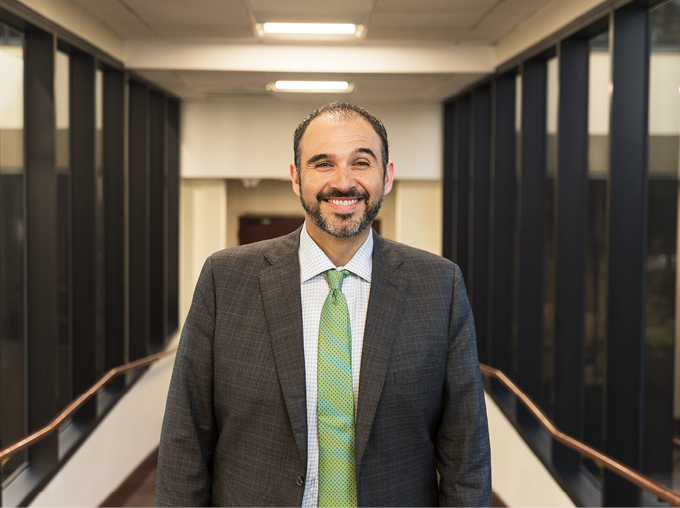Daniel Gandarilla was always drawn to the idea of helping people — though he wasn’t entirely sure which path to follow. He began his college career studying psychology but switched to education. After getting a master’s degree, he taught middle school and high school, volunteered with the Red Cross, and spent time in Mexico City teaching English to American Express executives.
He didn’t find his true calling until he returned from Mexico and was promoted to director of student activities at the school he was teaching at during the time. That’s when he realized he wanted to build a career in educational leadership. “I loved it,” he said. So he went to Texas Christian University’s Neeley School of Business to pursue a dual Master of Business Administration/doctorate in education — and it changed his life.
In his first year, Gandarilla landed a summer internship at Procter & Gamble’s corporate university, and the following year, he met the now former chief learning officer at Texas Health Resources in Arlington, Texas. “He heard about the internship I did for P&G and said, ‘Come work for me,’ ” Gandarilla said. In 2012, he was hired as an organizational design consultant and was quickly promoted to manager and director. By 2015 he was the new vice president and CLO.
“We are creating a new vision of the employee value proposition at Texas Health and Daniel plays a key role in making that new vision a reality,” said Michelle Kirby, executive vice president and chief people officer. “I have no doubt he is up to this task.”
Texas Health Resources is one of the largest faith-based, nonprofit health care delivery systems in the United States and the largest in North Texas in terms of patients served. The organization serves patients in 16 counties through 29 hospitals, all owned, operated, joint-ventured or affiliated with the system. It employs roughly 25,000 people and has more than 6,000 physicians with active staff privileges.
Gandarilla’s rapid evolution from consultant to leadership required him to mature quickly into a leader who can command the respect and loyalty of his teams. Kirby noted that he faced some unique challenges early on. “As a first-time chief learning officer, Daniel has had to persuade people to see him differently,” she said. Like most first-time leaders, he had to figure out how to convince people to follow him. “Some people make this transition successfully and others do not,” she said. “Daniel has been very successful stepping up into this role and after two short years, the organization cannot imagine a more suited CLO.”
A Single Source for Learning
One of the first initiatives Gandarilla launched as CLO was the Education Advancement Program, an overarching project to streamline learning and increase quality and access to training for Texas Health employees. This organizationwide change effort set the tone for Gandarilla’s leadership. “My approach is to look at every problem through the lens of who is involved and what education is appropriate to help them improve their performance,” he said.
He used this philosophy to determine where and when to merge learning programs and eliminate redundant content, and it drove the decision to centralize all instructional design and delivery within Texas Health Resources University, or THRU, which now oversees all training for the organization. “We saved $2 million in year one from that initiative alone, which has allowed us to implement new programs,” he said.
The centralization caused significant disruption in the organization because it took training oversight and resources away from the individual hospitals and clinics and funneled them to THRU. But Gandarilla made sure each facility saw value in the transition, said Asia Wellington, manager of learning and leadership development. Previously, each hospital had one or two resources to manage all learning. To balance the loss of those resources, Gandarilla created regional “pods” made up of a learning technology coordinator, learning development consultant, clinical educator and an academic liaison to address all of the needs of the facilities in each region. “It made them feel like they got more overall value by giving up those resources,” Wellington said.
This is the kind of innovative thinking that has won Gandarilla fans across the organization, said Kirby. She noted that he is especially good at collaborating with stakeholders across the organization and listening to their needs before suggesting solutions. “Additional training is not the answer to every problem, and Daniel knows how to work with leaders to help them think through other alternatives,” she said.
Training With Dummies
In his three years as CLO, Gandarilla has also helped expand several of the organization’s leadership training programs, including Physician’s Lead!, which provides leadership training to Texas Health physicians. He also led an effort to create an online career development portal for employees, revamped the employee orientation program, and created a learning and education cabinet chaired by executives to involve leaders in determining the direction that the learning organization will take going forward. “We laid out the things we want to do, focusing on how we can use technology to improve targeted education,” he said.
He is now working on a pilot project to use data-driven analytics to help employees customize their learning paths, as well as rethinking the organization’s approach to mandatory training so they can provide the necessary education without wasting employees’ time. “The data shows that healthcare professionals spend 80 percent of their time in required training,” Gandarilla said. He wants to clean up that process so employees can still meet their certification requirements but in fewer hours, allowing them to spend more time improving their skills and adapting to the transforming health care environment.
Gandarilla now refers to himself as the “Chief Time Enforcement Officer” and is looking for every opportunity to streamline the training workflow for employees. In one simple example, he eliminated a mandatory annual 15-minute video on dealing with an active shooter for any of the 25,000 employees who already viewed it, replacing it with a much shorter summary. “It saved hundreds of thousands of dollars, and thousands of hours of their time,” he said.
He’s also deployed artificially intelligent mannequins that provide simulated lifesaving scenarios and automatically report results back to the trainee and to the regulatory bodies. “Employees used to have to take a mandatory life-support class every year,” he said. Now they can demonstrate their skills on the dummy, get immediate feedback and continuously renew that certification without attending a formal class.
Gandarilla is currently exploring how THRU can bring accreditation processes in-house so employees can receive ongoing certifications more simply and in less time than it would take to complete the programs through accrediting bodies or external universities. “It’s all about disrupting the traditional ways of thinking about training,” he said. “No one gave me the directive to blow everything up, but challenging the way things are done is how you figure out what’s best for the organization.”
Quiet Disruption
Gandarilla may have disruptive ideas, but his colleagues repeatedly point to his quiet and collaborative nature. “People respond very well to his gentle style of leadership and humility,” Kirby said. “People feel like their voices are being heard and valued.”
Jennifer Chavez, associate chief nursing officer, agrees. Chavez began working at Texas Health as a patient care technician when she was just 17 years old and has worked her way up through the organization, taking every training and leadership program available to her. She currently works closely with Gandarilla, who she views as a mentor and peer.
Chavez first began working with Gandarilla when he was the sponsor for a cross-department team of leaders working on a knowledge management analysis project. Like Kirby, she admires his “lead from beside” approach. “Many leaders in health care have a hierarchical presence and ‘power over the people’ attitude, but not Daniel,” she said. “He has the perspective to step back and look at us as individuals so he can leverage the strength in the group.”
She also appreciates his willingness to immerse himself in the organization. She recalls calling him with concerns that some changes in the way patient care was being delivered weren’t being adopted across the nursing staff. He turned up a few days later and sat through three focus groups of nurses to figure out what the problem was and how it could be addressed. He never criticized anyone or identified fault, Chavez noted. He just went back to his office and implemented some changes as part of the broader process improvement effort. Then he checked back in with Chavez a few weeks later to see how things were going.
“He never said what actions he took, but I saw the positive change,” she said. Nurses were happier, and key performance measures around catheter-associated urinary tract infections, central line-associated blood stream infections and sepsis mortality all showed consistent improvement. This is one of many examples of his nonpunitive approach to problem solving, she said. “He just wants to help people do their jobs confidently and competently.”
Prescribing Change
While Gandarilla is often in disruption mode, looking for the next opportunity to improve learning delivery, he is surrounded by a team of leaders who keep him grounded and help him focus on the best next problem to tackle. “He is a change agent, the kind of leader who gets in front of an issue and is always looking for a way to do things better,” Wellington said. “We provide the balance to make sure he can deliver those plans.”
Kirby added that leaders like Gandarilla are vital to organizations that want to evolve the learning culture so they can deliver more value to the business while helping employees develop the skills they need for the future. “Health care in general is in a state of constant change as we reimagine the future of health care and how we will survive,” she said. “Daniel appreciates and understands that reality and does his part to ensure that THRU remains relevant to the organization’s mission, vision and strategic objectives. These leadership skills and acumen are extremely important to be a successful CLO.”















